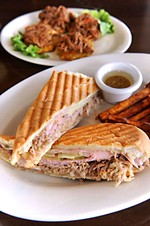A Primer on Peppers
The Fire Behind the 'Austin Chronicle' Hot Sauce Festival
By Mick Vann, Fri., Aug. 24, 2001
Hot Sauces Around the World
Prior to the introduction of chile peppers to the Old World by explorers, the spice of choice was the black peppercorn. But once the chile pepper arrived, it was widely adapted within the amazing time span of only a few decades into the cuisines of almost every region to which it had been introduced.
Once established, the variety of chiles available greatly increased due to several factors. Chiles are relatively easy to cultivate in compatible environments, and they cross-pollinate and hybridize freely with each other to produce new strains. When they are introduced to an environment they prefer, they naturalize and escape cultivation. Birds are excellent vectors for dispersal, because birds are immune to the heat of capsaicin, and the seeds pass freely through their digestive systems without damaging the chile's capacity to reproduce. Thus the seeds are replanted continuously in areas that birds inhabit (including long-distance migratory routes).
Once ripe and dried, chiles are lightweight and easily transported for trade and barter, and they also serve as a renewable source for seeds to produce new crops. This ensures that in the tropics, chefs can chose between either the green or ripe, fresh forms of chiles in dishes, as both are readily available. In cooler climates, when chiles are used, cooks are generally limited to unripe green chiles (which are still quite spicy) because the seeds often don't have time to mature before the arrival of frost. They also have the luxury of utilizing ripe, dried chiles imported from warmer areas.
Most cold-climate cooks shun very spicy foods, with several glowing exceptions. Perhaps the hottest salsa we have ever tasted -- the Sonam Penzom Sibeh -- comes from Nepal, and uses an astounding half-cup of dried Thai-style chiles, as well as six fresh Thai-style chiles, to heat up a paltry cup of sauce, which is usually ever-present as a table condiment. The taste is searingly spicy, but so addictive it should be available by prescription only. In Korea (known for its cooler climes), almost every dish and relish will have red chile in it in some form or another. And in the high altitude steppes of South Asia, chile sauces made from hot peppers blended with onions and herbs can be quite piquant.
For the most part, China uses chiles only in table condiments, with the exception of the spicy cuisine of Hunan and Sichuan, where both chiles and Sichuan peppercorns are utilized with regularity. The Indian subcontinent is known for its spicy food (where chiles are used both in cooking and in most relishes), with that of South India and especially Sri Lanka having the reputation of being the spiciest.
Southeast Asia uses chiles freely, both cooked into dishes, and in numerous table sauces and condiments. The foods of Burma and Thailand are probably the most intense, heat-wise, while Laos, Cambodia, and Vietnam heavily utilize chiles in accompanying sauces, so that the diner can add accordingly.
Indonesia and the Philippines can produce some spicy cuisine, but again, the really hot stuff is reserved for condiments, rather than added to the dish in large amounts while cooking. In the Pacific Islands grilled boonie chiles are used in sauces and cooked into dishes with regularity, while the foods of Australia and New Zealand, further south, tend to follow the pale, unexciting example of the Brits.
Regional Africa can show some spunk spice-wise, especially on the eastern coast, Ethiopia, and the equatorial zones. In the Maghreb (North Africa), the foods aren't cooked with many chiles, but the table chile sauces are incendiary, especially in Tunisia, where the harissa sauce made from chiles, caraway, and herbs is scorchingly hot.
The Mediterranean countries of Europe have the highest use of chiles in that region, although by Texan standards the heat can be considered tame. The Middle East and the Near East heavily utilize spices, but not chiles to any great degree, and forget Eastern Europe, Northern Europe, Russia, and Scandinavia -- nary a spicy chile to be found in any of these regions. Horseradish and paprika are the hottest things going on there, and they are used sparingly at best.
South America, the original home of the chile pepper, harbors some fairly intense chile usage, particularly in Brazil, where the malagueta chile reigns supreme. Peru and Bolivia use the aji chile to perfection, while much of the rest of the continent's cuisine was too heavily influenced by the Spaniards to have retained much piquancy.
One would think that with Central America being the land bridge for chile passage to the north that the food would be fairly spicy, but hot sauces made from chiles are used sparingly as table condiments, and hot chiles are rarely used in cooked dishes. The Caribbean has warmly embraced the chile pepper on all islands, and the habanero, Scotch Bonnet, or Jamaican red have worked their way into many dishes, creating a regional cuisine well known for its heat.
Mexico, as we Texans know, can have dishes that are incredibly hot, as well as sauces that are refined and mild, and the region is one of the heaviest consumers of chiles (in all of its abundant forms) in the world. North America follows the cold climate = no chile rule to perfection, but the influence of fast foods and processed foods is slowly converting Yankees and Midwesterners to our spicy side of the table.
As soon as the word gets out, local chile heads will be clamoring for the world's newest, hottest chile. In August 2000, biologists in India reported the discovery of a new chile cultivar being grown (apparently for quite some time, however) in the hills east of the central Assamese town of Tezpur, close to the Indian-Burmese border. Dubbed Capsicum frutescens cv. nagahari by pepper experts, the chile is commonly known as "Tezpur chile," "Naga jolokia," or just "Indian PC-1."
The Indian PC-1 designation was applied by Indian military researchers who were looking for the hottest chile extracts to be used for pepper sprays and powders in riot and crowd control. Previously, the Red Savina habanero held the title, testing out at 560,000 Scoville units, or 3.7% capsaicin, but the new King Tezpur peaks at a blistering 855,000 Scoville units, or a whopping 5.7% capsaicin. Seeds are available from www.reimerseeds.com. News of the find should release a flurry of inquiries, ample enough to tie up the switchboards at Central Market for weeks.








